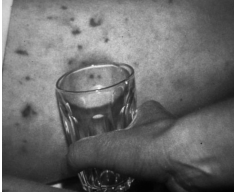Your child is well enough to go home now, but if you become worried or you are concerned that you are unable to look after your child at home because:
- Your child’s health gets worse.
- Your child has a fit.
- Your child develops a rash that does not disappear with pressure (see the ‘tumbler test’ section).
- The fever lasts longer than 5 days.
- You are concerned your child is dehydrated (see section below).
Then phone 111 for further advice or contact your own GP surgery. In an emergency always dial for an ambulance 999.
What to do when your child has a fever
- Offer your child regular drinks (if you are breastfeeding then breast milk is best)
- Check for signs that your child may be dehydrated (dry mouth, no tears, sunken eyes, sunken fontanelle – the soft spot on a baby’s head). If you notice any of these signs seek further advice (see section above).
- Check your child for rashes and know how to look for and identify a non-blanching rash (a rash that does not disappear with pressure) as that could be a sign of serious illness (see tumbler test section).
- Check on your child during the night.
- Do not try to reduce your child’s fever with medicine, but do use medicines (see medicines section) if your child is distressed or uncomfortable.
- Keep your child away from school or nursery while they have a fever and notify them of your child’s absence.
- Return a urine sample if one has been requested, ideally within 24 hours.
Fever and Medicines
Fever is a natural and healthy response to infection, so do not try to reduce your child’s fever by over or under dressing them, or by sponging them with water.
Although it is not necessary to treat fever, there are two medicines that can be used to treat distress caused by fever and being unwell. These are ibuprofen and paracetamol and they may make your child feel better. They are equally effective, so you should start with one and only use the other if the first has not worked, but you should not give both at the same time.
Read the instructions carefully as these medicines come in different strengths, and they may also be contained in other products that your pharmacist sells. If you have any doubt you should tell the pharmacist what you are currently using. Although both are very safe when used correctly, they may be harmful if too large a dose is given or if given too often.
Rashes and the tumbler test
Do the ‘tumbler test’ if your child has a rash.
Press a glass tumbler firmly against the rash.

If you can see the spots through the glass and they do not fade this is called a ‘non-blanching rash’. If this rash is present seek medical advice immediately.
If the spots fade when the glass is rolled over them, the rash is probably not serious, but keep checking, it can develop into a rash that does not fade.
Rashes are harder to see on dark skin so look for rashes on paler areas, such as palms of the hands, soles of the feet, tummy and inside the eyelids.
If you are worried that your child’s health is getting worse, seek further medical advice – do not wait for a rash to appear.
Please contact your GP or NHS 111 for any queries or concerns.